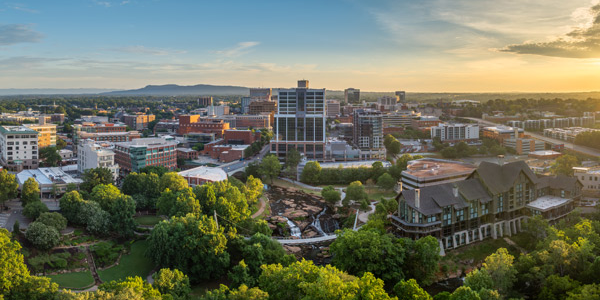
Greenville city engineers are moving into the second and final phase of the Downtown Transportation Master Plan — continuing efforts to keep the city moving safely and efficiently.
Over the past five years, Greenville has completed 28 improvement projects — including upgrades from Main Street to Heritage Green and new dual left-turn lanes onto 385 at Laurens Road and Stone Avenue.
Phase Two will focus on larger projects — redesigning the 385 interchange at East Stone Avenue and Laurens Road, and the intersection of North Academy and East North Street. Plans also call for new sidewalks, intersection and signal upgrades along Church Street, plus bike and pedestrian improvements on Pete Hollis Boulevard.
Engineering Services Director Clint Link says the next step is securing funding and beginning design work once City Council finalizes its priorities.
Press release from the City of Greenville below:
Master Plan Provides Foundation for Council to Set Priorities
As downtown Greenville continues to grow, City engineers are keeping pace by assessing infrastructure needs to keep motorists, cyclists and pedestrians both safe and moving.
These recommendations are part of the ongoing Downtown Transportation Master Plan process, now entering its second and final phase. Engineering Services provided an update to City Council on the Phase 1 accomplishments over the past five years, as well as recommendations for key future priorities identified as part of Phase 2 of the project.
Among the top future transportation needs identified in the study:
A redesign of the I-385 interchange at East Stone Avenue and Laurens Road
Various intersection, sidewalk, and traffic signal improvements along the Church Street (US 29) corridor
Redesign of the intersection of North Academy and East North Street
Multi-modal bike and pedestrian improvements along Pete Hollis Boulevard, the city’s northern gateway
Director of Engineering Services, Clint Link said the work will result in a planning-level document to serve as the foundation for future capital improvement projects. “The next steps are to identify project funding and move forward with engineering design, based on Council’s decisions,” Link said.
Work on the Downtown Transportation Master Plan started in 2018, when City engineers began to assess existing conditions and prioritize needs. The result: a two-phase project to first identify short-term projects (Phase 1) and gather conceptual ideas for long-term needs (Phase 2).
Over the past five years, the City has moved forward with 28 projects identified in Phase 1. Notable projects completed or under construction include:
Improvements to the Cultural Corridor from Main Street to Heritage GreenThe East North Street gateway enhancements
Addition of a pedestrian hybrid beacon along Rutherford StreetAddition of dual left-turn lanes onto Highway 385 at Laurens Road and Stone Avenue intersection
Reduction of lanes along Pendleton Street and addition of a protected bike lanes
Next steps on the larger Phase 2 projects will require coordination with partners such as the state Department of Transportation (SCDOT) and the Greenville-Pickens Area Transportation Study (GPATS), along with an effort to leverage federal, state, local and private funding.